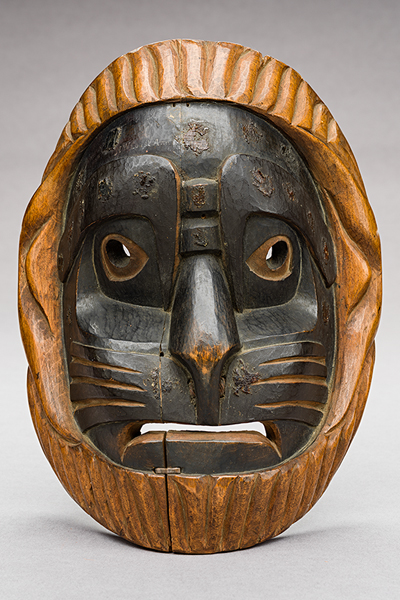James Scarborough and
Lt. Charles Wilkes of the U.S. Exploring Expedition
The U.S. Exploring Expedition was the first large-scale scientific study commissioned by the United States government. The pioneering journey was authorized by congress in 1836 in response to the government’s increased interest in international affairs and pursuit of global power, and was the last major nineteenth-century sailing voyage to circumnavigate the world.
The expedition set sail from Virginia in August 1838. Over the course of four years and 87,000 miles, it surveyed 280 Pacific islands and 800 miles of coastal Oregon, known at the time as the Oregon Territory, and most famously discovered the Antarctic continent. Commonly referred to as the Wilkes Expedition, the voyage was led by Lt. Charles Wilkes (1798-1877) and consisted of six ships and 346 men, of whom nine were trained scientists and artists. Wilkes was a New York aristocrat and the Head of the U.S. Navy’s Department of Charts and Instruments at the time of his appointment. Although he lacked practical command experience, he was known for his talent in the natural sciences and surveying. Included in the scientific corps were naturalists Titian Ramsay Peale and Charles Pickering, who co-authored an immense catalog of over 4,000 natural history, ethnographic, and archaeological materials collected during the expedition.
In May 1841, Wilkes and his crew arrived in the Oregon Territory, which was jointly occupied by the United States and Britain. With both countries vying for permanent ownership of this vast region, the expedition’s documentation of the Territory was of particular political importance. During their three-month stay on the Pacific Coast, Wilkes’s men travelled to numerous Hudson’s Bay Company (HBC) outposts, including Forts Nisqually and Vancouver, and conducted surveys of various waterways, islands, and bays.
Throughout their stay on the Coast, the expedition collected approximately 300 regional, Indigenous-made objects. These included wooden masks and rattles, model canoes and paddles, bows and arrows, cedar-bark capes, woven blankets and belts, and argillite and ivory pieces. Wilkes’s records indicate that objects originating from peoples north of the Oregon Territory, such as the Kwakwaka’wakw, were given or sold to the crew by workers of the HBC. Hudson’s Bay Company employee Captain James Scarborough (1805-1855), born in England and married to a Chinook woman, was one of the most active liaisons between the HBC and Wilkes. Today, he is credited with having collected the majority of the expedition’s Northwest Coast material. Primarily a ship captain, Scarborough had no scientific training, and the expedition crew lacked a trained ethnologist to properly document these acquisitions. The crew did include Horatio Hale, an amateur linguist, and Charles Pickering, an evolutionary biologist, but neither had any clear influence on the selection of materials collected. As a result, objects were acquired as “curiosities” with little contextual information, and were likely understood as evidence for cultural evolutionism by members of the expedition and government alike.
When the expedition returned to New York in 1842, the collection was transferred to the National Institution for the Promotion of Science, and Wilkes authored and published his Narrative of the United States’ Exploring Expedition. In subsequent years, selected objects were exhibited in the Patent Office’s Great Hall, and in 1857 the U.S. Congress transferred 2,516 objects to the newly formed United States National Museum, a branch of the Smithsonian Institution (today the Smithsonian National Museum of Natural History). The museum opened to the public in 1881, and the Wilkes materials served as one of the Institution’s founding collections. With the Smithsonian’s aim of “diffusing knowledge,” other parts of the collection were then dispersed to over 40 institutions around the world. Only one piece from the Wilkes Expedition—a mask with a particularly complex history—was included in Boas’s 1897 text, likely based on Boas having seen it on earlier visits to the U.S. National Museum.
By Lillia McEnaney
Objects Collected by Scarborough, Wilkes, and the U.S. Exploring Expedition
SOURCES:
Accession #66A00050: Wilkes Expedition 1841. Smithsonian National Museum of Natural History.
Buerge, David M. “The Wilkes Expedition in the Pacific Northwest.” Columbia Magazine 1(1): 17- 32, 1987.
Cole, Douglas. Captured Heritage: The Scramble for Northwest Coast Artifacts. Seattle: University of Washington Press, 1985.
Joyce, Barry Alan. The Shaping of American Ethnography: the Wilkes Exploring Expedition, 1832-1842. Lincoln: University of Nebraska Press, 2001.
Peale, T.R. “Collections of the United States South Sea Surveying and Exploring Expedition 1838, 9, 40, 41 & 42.” Manuscript 4807, National Anthropological Archives, Smithsonian Institution. U. S. Patent Office, 1846.
Philbrick, N. Sea of Glory: America’s Voyage of Discovery: the US Exploring Expedition, 1832-1842. New York: Viking, 2003.
———. “The Scientific Legacy of the U.S. Exploring Expedition.” Smithsonian Institution, Digital Collections Website on United States Exploring Expedition, 1838-1842. https://www.sil.si.edu/DigitalCollections/usexex/learn/philbrick.htm. (Accessed April 27, 2019).
Record Unit 7058, National Institute Records, Smithsonian Institution Archives.
Ruane, Michael. “Remembering the Last Great Worldwide Sailing Expedition.” Smithsonian Institution Magazine, April 2013.
Stanton, William Regan. The Great United States Exploring Expedition of 1832-1842. Berkeley: University of California Press, 1975.
Viola, Herman J., and Carolyn Margolis. Magnificent Voyagers: The U.S. Exploring Expedition, 1832-1842. Washington DC: Smithsonian Institution Press, 1985.
Walsh, Jane. “From the Ends of the Earth: The United States Exploring Expedition Collections.” Smithsonian Institution, Digital Collections Website on United States Exploring Expedition, 1838-1842. https://www.sil.si.edu/DigitalCollections/usexex/learn/Walsh-01.htm (Accessed April 27, 2019).



